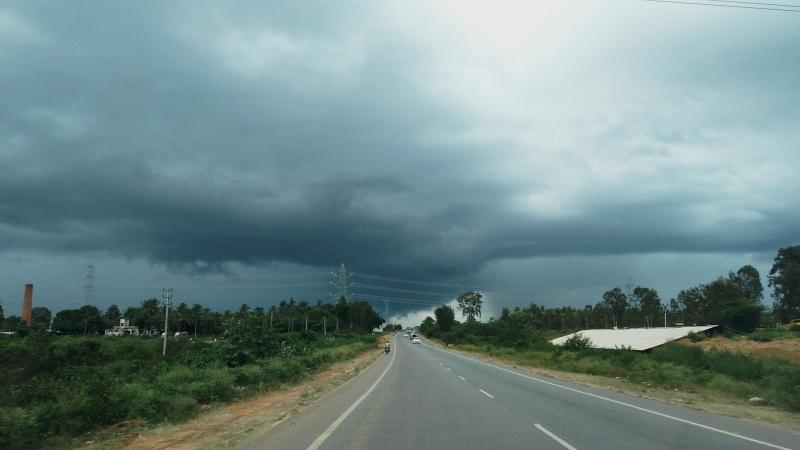
The Indian summer monsoon rainfall, which typically lasts from June to September, accounts for nearly 75% of the annual rainfall received pan India. During these four months, the Indian meteorological department estimates that central India gets 88%, north-western and eastern regions of India receive 71%, and southern India receives 63% of their total yearly rainfall.
Studies show that the Indian summer monsoon rainfall varies over time – ranging from biennial to interdecadal periods. For example, the El-Niño southern oscillation cycle, driven by the fluctuations in the sea surface temperature of the Pacific Ocean, strongly influences the strength of the Indian monsoon. While the warm phase of this cycle results in El-Niño years characterised by weak monsoon rains, the cold phase leads to La-Niña years associated with a strong Indian monsoon. A few studies over the last two decades have suggested that multidecadal variability could be significantly influencing the occurrences of floods and droughts. However, since the rainfall data is only available for the past 150 years, extracting the multidecadal variability in Indian monsoon is quite strenuous.
Now, researchers from the Indian Institute of Science, Bangalore; Indian Institute of Tropical Meteorology, Pune; and Florida State University, USA; have mathematically computed a multidecadal variability in the Indian summer monsoon rainfall and the global sea surface temperature. They have established that Indian monsoon rainfall exhibits a 67-year oscillation and is closely linked to the sea surface temperature cycle, which also shows a similar 67-year swing. The study also shows that 80% of all droughts have occurred in the rainfall cycle’s ‘negative phase’, associated with a below-average rainfall; whereas 60% of all floods have occurred in the positive phase, marked with above-average precipitation. Their findings have been published in the Quarterly Journal of the Royal Meteorological Society.
Why is it necessary to understand the multidecadal variability in the Indian monsoon?
“Since the last few decades, under a rising temperature scenario due to global warming, a few studies have shown that the contribution of decadal variability in surface air temperature to the mean rainfall has gradually decreased,” explains Dr Nirupam Karmakar, the lead author of the study. He is currently a postdoctoral researcher at the Florida State University. “At this point, it is very critical to understand and distinguish the natural variability and the changes induced by human activities in rainfall patterns across the world, and especially over the highly populated areas like south Asian region,” he adds.
For the current study, the researchers collected monthly rainfall data from June to September from 1871 to 2016, and monthly global sea surface temperature data for the same period. The mean rainfall and spatial patterns of the surface temperature for each year were used for the computation. Both sets of data were normalised and filtered to remove El-Niño-related cycles. The resulting datasets were analysed using a spectral estimation method called Singular Spectrum Analysis to extract the variability observed in the rainfall pattern and the sea surface temperature.
The results showed a multidecadal variability in the Indian summer monsoon rainfall data, exhibiting a 67-year cycle consisting of a positive phase and a negative phase. Within the calculated period, the years 1871-1897 and 1931-1964 corresponded to positive phases; and the years 1898-1930 and 1965 onwards corresponded to negative phases. The researchers observed that out of the 22 floods and 25 droughts during 1871-2016, 13 floods (60%) occurred in the positive phases, and 20 droughts (80%) occurred in the negative phases of the cycle.
Interestingly, the analysis on the sea surface temperature values also yielded a multidecadal 67-year oscillation similar to the monsoon cycle. Mapping of the surface temperature values across all the oceans indicated that during the warm phase of the sea surface temperature cycle, the north-Pacific and north-Atlantic regions were comparatively warmer. Correspondingly, during the cold phase, these regions were relatively cooler than the other ocean surfaces.
The sea surface temperature cycle was found to precede the monsoon cycle by two-three years, implying that the warm phase enforces a wetter phase of the monsoon and vice versa. This association was notably stronger during the period 1871-1990, establishing a strong link between the global sea surface temperature and the Indian summer monsoon.
“Changes in sea surface temperatures could modulate the multidecadal variations in rainfall over India by changing the surface pressure over the northern Arabian Sea,” states Dr Karmakar, explaining the mechanism driving this linkage. “It is associated with the changes in surface conditions and circulation over central Asia, possibly through the north-Pacific oscillation,” he adds.
In other words, during the warm phase, the temperature gradient increases over the Indian region, creating favourable conditions for the enhanced monsoon rainfall.
However, after 1990, this correlation between sea surface temperature and summer monsoon rainfall was seen to weaken. The mean monsoon rainfall remained almost constant, although the sea surface temperature still followed the specified cycle. One of the reasons for this abnormality, the researchers say, could be the dampening of the large-scale monsoon circulation caused by the inhomogeneous warming due to greenhouse gases in recent decades.
The researchers are now aiming to perform numerical simulations to understand the mechanism on how the global sea surface temperatures modulate the Indian summer monsoon in greater detail. “Also, using climate model simulations, we will investigate what exactly caused the weakening in the relationship between the Indian summer monsoon rainfall and the sea surface temperature after the 1990s,” shares Dr Karmakar.
This article has been run past the researchers, whose work is covered, to ensure accuracy.






